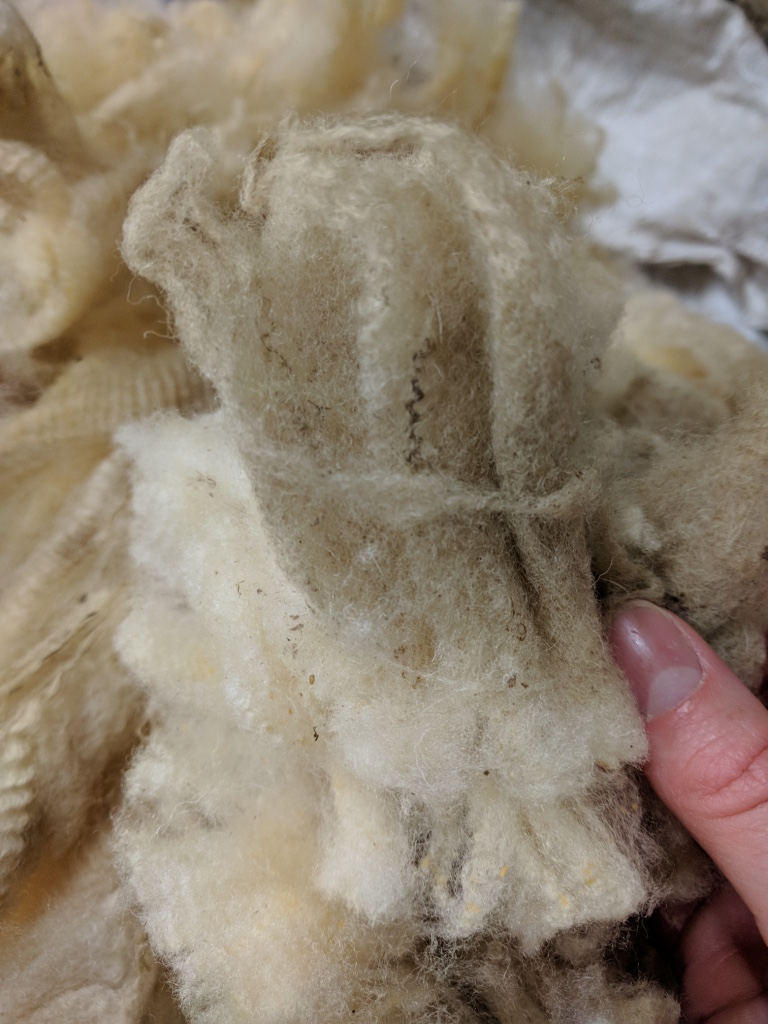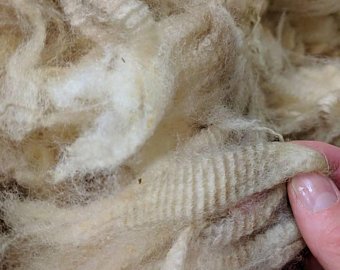There are many different types of sheep fleece available for sale online. Choosing the right fleece for you can be difficult. So we’ve put together this page to explain some of the key concepts you should understand before selecting the right raw fleece for your project.
Raw Sheep Fleece
This is sheep fleece as it comes off the Sheep, without washing or processing. All of our fleeces are sold as raw fleece, lightly skirted.
Greasy Fleece
As our fleeces are not washed they are rich in natural lanolin, so have a “greasy” texture. This is what is meant by Greasy Fleece.

First Sheer Fleece

When the sheep is about 14 months old it is sheared for the first time, at this point it becomes a Shearling. This First Shear is sometimes called a Lambs Fleece. The first fleece is the finest fleece that sheep will produce. It is often softer than the subsequent fleece from the same sheep. As we breed our own replacement ewes we have good quality first shear fleeces available every year.
Ewes Fleece
The second and subsequent shearings of each sheep are referred to as Ewes fleece. Due to the breeds we keep, the quality of the fleece does not diminish as the sheep gets older.
Rams Fleece
This relates tot he fleece from a Ram. These are very similar in texture to a Ewes fleece, but have a slightly stronger sheepy smell. This smell completely disappears on washing.
Glossary of Commonly used Sheep Fleece Terms
Staple Length
Staple Length refers to the length of the individual fibres on the fleece. Some of ours exceed 4″ in length. Most rare and native breed sheep have a longer staple length than imported commercial breed sheep. This is because they descend from sheep whose fleece was used for clothing. However longer is not always better and you may be looking for a medium staple length such as our shetland cross cheviot for some spinning.
Crimp
The Crimp is the natural wave to the fleece, some fleeces such as Shetland Sheep Fleece have more natural crimp than others such as Boreray Sheep Fleece.
Skirting
Skirting is the removal of less desirable or dirty parts of the fleece, this is typically around the rump of the sheep. All of our fleeces are lightly skirted, but with all raw/ greasy fleeces some dirt may remain.
Second cuts
Second cuts refers to really short fibres that are caused by the shearer going over the same part of the sheep twice. We have very few second cuts on our fleeces as each sheep is shorn on the farm by professional shearers.
Curl
Curl relates to the natural curl within the fleece, this is much rarer than crimp. We see natural curl in some of our lighter coloured Icelandic Sheep fleeces.
Vegetable matter
Vegetable matter (VM) means any dirt present in the fleece. This normally could be mud, small pieces of hay if the animal has been fed hay, weeds from the field, small strands of grass, or even poo. All raw fleeces have some vegetable matter in, ours have very little.
Lanolin
This is the natural oils secreted by the sheep through its skin. When a fleece is rich in lanolin it feels greasy to the touch. The lanolin sometimes appears as small yellowy- brown flecks in the fleece.
Extra information
Shetland Sheep Society More information about Shetland Fleeces can be found here.
